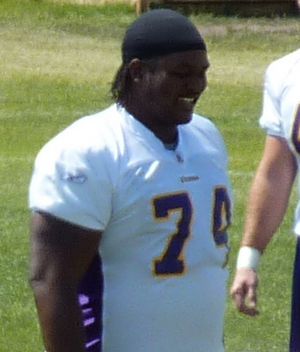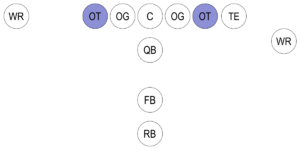Tackle (gridiron football position) facts for kids
In gridiron football, a tackle is a player position. Long ago, in the early days of football, one player would play both offense and defense. But today, players have special jobs. The term "tackle" usually means the offensive tackle.
An offensive tackle (often called OT or T) is part of the offensive line. There's one on the left and one on the right. Their main job is to block. This means they physically stop defenders from reaching the player who has the football. By blocking, they help their team move the ball forward and score a touchdown.
Offensive tackles are very strong players on the team. They use quick steps and good movement to make powerful blocks. They are mostly in charge of protecting the outside edges of the offensive line. They often block against defensive ends. Sometimes, they also block defensive tackles, especially if a nearby guard player moves out of position. In the NFL, offensive tackles are usually very tall, often over 6 feet 4 inches (193 cm). They are also very heavy, often over 300 pounds (136 kg). This makes them generally the tallest and heaviest players in football.
Football experts like Paul "Dr. Z" Zimmerman have noted that offensive tackles often score well on the Wonderlic Test. This test is taken before players are drafted into the NFL. It helps to see how well players can learn and solve problems.
While both right and left tackles are important, their specific roles can be a bit different.
Right Tackle: The Run Blocker
The right tackle (RT) is usually one of the team's best players at blocking for running plays. Most running plays go towards the "strong side" of the offensive line. This is the side where the tight end player lines up. Because of this, the right tackle often faces the defending team's best players who stop runs. The right tackle must be able to get good grip and push in their blocks. This helps the running back find a space to run through.

Left Tackle: The Pass Protector
The left tackle (LT) is usually the team's best player at blocking for passing plays. Left tackles often have better footwork and quickness than right tackles. This helps them stop defensive ends who are trying to rush the quarterback.
When a quarterback throws a forward pass, they usually turn their body. For right-handed quarterbacks (which is most of them), their back is turned towards defenders coming from the left side. This creates a "blind side" that the left tackle must protect. It's a very important job! If a team has a left-handed quarterback, they might have their best pass blocker at the right tackle position instead, for the same reason.
A book called The Blind Side: Evolution of a Game by Michael Lewis was made into a movie in 2009. This book and movie helped people understand how important the left tackle position is. They showed how the salaries for left tackles in the NFL grew very quickly in the mid-1990s. Top left tackles are now highly wanted by teams. They are often the second-highest paid players on a team, right after the quarterback.
In recent NFL drafts, many left tackles have been chosen very early. For example, in the 2013 NFL Draft, three of the first four players picked were left tackles. This shows how valuable they are. Some examples of top left tackles picked early include Eric Fisher (2013, 1st pick), Luke Joeckel (2013, 2nd pick), and Lane Johnson (2013, 4th pick).
See also
 In Spanish: Tackleador para niños
In Spanish: Tackleador para niños



